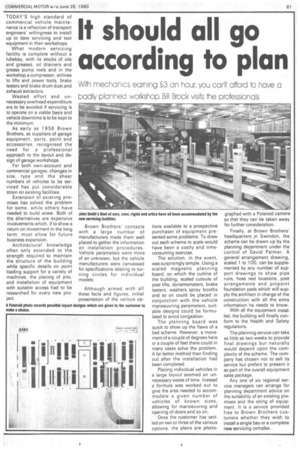It should all go according to plan
Page 63

If you've noticed an error in this article please click here to report it so we can fix it.
TODAY'S high standard of commercial vehicle maintenance is a reflection of transport engineers' willingness to install up to date servicing and test equipment in their workshops.
What modern servicing facility is complete without a lubebay, with its stocks of oils and greases, oil drainers and grease pump reels and in the workshop a compressor, airlines to lifts and power tools, brake testers and brake drum dust and exhaust extractors.
Wasted effort and unnecessary overhead expenditure are to be avoided if servicing is to operate on a viable basis and vehicle downtime is to be kept to the minimum.
As early as 1956 Brown Brothers, as suppliers of garage equipment, parts, paint and accessories, recognised the need for a professional approach to the layout and design of garage workshops.
For both own-account and commercial garages, changes in size, type and the sheer numbers of vehicles to be serviced has put considerable strain on existing facilities.
Extension ot existing premises has solved the problem for some, while others have needed to build anew. Both of the alternatives are expensive involvements which, if to show a return on investment in the long term, must allow for future business expansion.
Architectural knowledge often only extended to the strength required to maintain the structure of the building while specific details on point loading support for a variety of machines, the placing of pits, and installation of equipment with suitable access had to be researched for every new project. Brown Brothers contacts with a large number of manufacturers made them well placed to gather the information on installation procedures. Vehicle parameters were more of an unknown, but the vehicle manufacturers were canvassed for specifications relating to turning circles for individual models.
Although armed with all these facts and figures, initial presentation of the various op tions available to a prospective purchaser of equipment presented some problems. To draw out each scheme to scale would have been a costly and timeconsuming exercise.
The solution, in the event, was surprisingly simple. Using a scaled magnetic planning board, on which the outline of the building, scaled cutouts of post lifts, dynamometers, brake testers, washers spray booths and so on could be placed in conjunction with the vehicle manoeuvring perameters, suitable designs could be formulated to avoid congestion.
The planning board was quick to show up the flaws of a bad scheme. However, a movement of a couple of degrees here or a couple of feet there could in many cases solve the problem. A far better method than finding out after the installation had been completed.
Placing individual vehicles in a large layout seemed an unnecessary waste of time. Instead a formula was worked out to give the area needed to accommodate a given number of vehicles of known sizes, allowing for manoeuvring and opening of doors and so on.
Once the customer has settled on two or three of the various options, the plans are photo graphed with a Polaroid camera so that they can be taken away for further consideration.
Finally, at Brown Brothers' headquarters ,in Swindon, the scheme can be drawn up by the planning department under the control of David Palmer. A general arrangement drawing, scaled 1 to 100, can be supplemented by any number of support drawings to show pipe runs, hose reel locations, post arrangements and pinpoint foundation pads which will supply the architect in charge of the construction with all the extra information he needs to know.
With all the equipment installed, the building will finally conform to the Health and Safety regulations.
The planning service can take as little as two weeks to provide final drawings but naturally would depend upon the complexity of the scheme. The company has chosen not to sell its service but prefers to present it as part of the overall equipment sales package.
Any one of six regional service managers can arrange for planning department advice on the suitability of an existing premises and the siting of equipment. It is a service provided free to Brown Brothers customers whether they wish to install a single bay or a complete new servicing complex.




































































































































